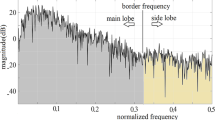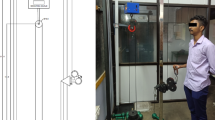Abstract
In the present contribution, a complexity measure is proposed to assess surface electromyography (EMG) in the study of muscle fatigue during sustained, isometric muscle contractions. Approximate entropy (ApEn) is believed to provide quantitative information about the complexity of experimental data that is often corrupted with noise, short data length, and in many cases, has inherent dynamics that exhibit both deterministic and stochastic behaviors. We developed an improved ApEn measure, i.e., fuzzy approximate entropy (fApEn), which utilizes the fuzzy membership function to define the vectors’ similarity. Tests were conducted on independent, identically distributed (i.i.d.) Gaussian and uniform noises, a chirp signal, MIX processes, Rossler equation, and Henon map. Compared with the standard ApEn, the fApEn showed better monotonicity, relative consistency, and more robustness to noise when characterizing signals with different complexities. Performance analysis on experimental EMG signals demonstrated that the fApEn significantly decreased during the development of muscle fatigue, which is a similar trend to that of the mean frequency (MNF) of the EMG signal, while the standard ApEn failed to detect this change. Moreover, fApEn of EMG demonstrated a better robustness to the length of the analysis window in comparison with the MNF of EMG. The results suggest that the fApEn of an EMG signal may potentially become a new reliable method for muscle fatigue assessment and be applicable to other short noisy physiological signal analysis.












Similar content being viewed by others
References
Ahmad, S. A., and P. H. Chappell. Moving approximate entropy applied to surface electromyographic signals. Biomed. Sig. Process. Contr. 3:88–93, 2008.
Bilodeau, M., S. Schindler-Ivens, D. M. Williams, R. Chandran, and S. S. Sharma. EMG frequency content changes with increasing force and during fatigue in the quadriceps femoris muscle of men and women. J. Electromyogr. Kinesiol. 13:83–92, 2003.
Bonato, P. Recent advancements in the analysis of dynamic EMG data. IEEE Med. Biol. Mag. 20(6):29–32, 2001.
Bonato, P., S. H. Roy, M. Knaflitz, and C. J. De Luca. Time-frequency parameters of the surface myoelectric signal for assessing muscle fatigue during cyclic dynamic contractions. IEEE Trans. Biomed. Eng. 48:745–753, 2001.
Caldirola, D., L. Bellodi, A. Caumo, G. Migliarese, and G. Perna. Approximate entropy of respiratory patterns in panic disorder. Am. J. Psychiatr. 161:79–87, 2004.
Chen, X. N., I. Solomon, and K. H. Chon. Comparison of the use of approximate entropy and sample entropy: applications to neural respiratory signal. In: Proceedings of the 2005 IEEE EMBS 27th Annual Conference, Shanghai, 2005, pp. 4212–4215.
Christen, J. A., J. L. Torres, and J. Barrera. A statistical feature of genetic sequences. Biometr. J. 40:855–863, 1998.
DeLuca, C. J. Myoelectric manifestations of localized muscular fatigue in humans. Crit. Rev. Biomed. Eng. 11:251–279, 1984.
Duchene, J., and F. Goubel. Surface electromyogram during voluntary contraction: processing tools and relation to physiological events. CRC Crit. Rev. Biomed. Eng. 21:313–397, 1993.
Erfanian, A., H. J. Chizeck, and R. M. Hashemi. Chaotic activity during electrical stimulation of paralyzed muscle. In: 18th Annal International Conference of the IEEE EMBS, Amsterdam, 1996, pp. 1756–1757.
Filligoi, G., and F. Felici. Detection of hidden rhythms in surface EMG signals with a nonlinear time-series tool. Med. Eng. Phys. 21(6–7):439–448, 1999.
Georgakis, A., L. K. Stergioulas, and G. Giakas. Fatigue analysis of the surface EMG signal in isometric constant force contractions using the averaged instantaneous frequency. IEEE Trans. Biomed. Eng. 50(2):262–265, 2003.
Hagg, G. M. Interpretation of EMG spectral alterations and alteration indexes at sustained contraction. J. Appl. Physiol. 73(3):1211–1217, 1992.
Hornero, R., D. Abasolo, J. Escudero, and C. Gomez. Nonlinear analysis of electroencephalogram and magnetoencephalogram recordings in patients with Alzheimer’s disease. Phil. Trans. R. Soc. A 367(1887):317–336, 2009.
Hou, Y., J. M. Zurada, W. Karwowski, W. S. Marras, and K. Davis. Estimation of the dynamic spinal forces using a recurrent fuzzy neural network. IEEE Trans. Syst. Man Cybern. B 37(1):100–109, 2007.
Hu, X., C. Miller, P. Vespa, and M. Bergsneider. Adaptive computation of approximate entropy and its application in integrative analysis of irregularity of heart rate variability and intracranial pressure signals. Med. Eng. Phys. 30:631–639, 2008.
Huang, N. E., Z. Shen, S. R. Long, M. L. C. Wu, H. H. Shih, Q. N. Zheng, N. C. Yen, C. C. Tung, and H. H. Liu. The empirical mode decomposition and the Hilbert spectrum for non-linear and non-stationary time series analysis. Proc. Roy. Soc. Lond. Ser. A 454:903–995, 1998.
Karlsson, S., J. Yu, and M. Akay. Enhancement of spectral analysis of myoelectric signals during static contractions using wavelet methods. IEEE Trans. Biomed. Eng. 46:670–684, 1999.
Karwowski, W., A. Gaweda, W. S. Marras, K. Davis, J. Zurada, and D. Rodrick. A fuzzy relational rule network modeling of electromyographical activity of trunk muscles in manual lifting based on trunk angels, moments, pelvic tilt and rotation angles. Int. J. Ind. Ergon. 36(10):847–859, 2006.
Katsev, S., and I. L’Heureux. Are Hurst exponents estimated from short or irregular time series meaningful? Comput. Geosci. 29:1085–1089, 2003.
Koskinen, M., T. Seppanen, S. Tong, S. Mustola, and N. V. Thakor. Monotonicity of approximate entropy during transition from awareness to unresponsiveness due to propofol anesthetic induction. IEEE Trans. Biomed. Eng. 53(4):669–675, 2006.
Lei, M., Z. Z. Wang, and Z. J. Feng. Detection nonlinearity of action surface EMG signal. Phys. Lett. A 290:297–303, 2001.
Linssen, W. H., D. F. Stegeman, E. M. Joosten, M. A. van’t Hof, R. A. Binkhorst, and S. L. Notermans. Variability and interrelationships of surface EMG parameters during local muscle fatigue. Muscle Nerve 16:849–856, 1993.
Liu, Y., M. Kankaanpaa, J. P. Zbilut, and C. L. Webber, Jr. EMG recurrence quantifications in dynamic exercise. Biol. Cybern. 90(5):337–348, 2004.
Lu, S., X. N. Chen, J. K. Kanters, I. C. Solomon, and K. H. Chon. Automatic selection of the threshold value r for approximate entropy. IEEE Trans. Biomed. Eng. 55(8):1966–1972, 2008.
MacIsaac, D. T., P. A. Parker, K. B. Englehart, and D. R. Rogers. Fatigue estimation with a multivariable myoelectric mapping function. IEEE Trans. Biomed. Eng. 53(4):694–700, 2006.
Merletti, R., M. Knaflitz, and C. Deluca. Myoelectric manifestations of fatigue in voluntary and electrically elicited contractions. J. Appl. Physiol. 69:1810–1820, 1990.
Nargol, A. V., A. P. Jones, P. J. Kelly, and C. G. Greenough. Factors in the reproducibility of electromyographic power spectrum analysis of lumbar paraspinal muscle fatigue. Spine 24(9):883–888, 1999.
Pincus, S. M. Approximate entropy as a measure of system complexity. Proc. Natl Acad. Sci. USA 88:2297–2301, 1991.
Pincus, S. M. Approximate entropy in cardiology. Herzschr. Elektrophys. 11:139–150, 2000.
Pincus, S. M. Approximate entropy as a measure of irregularity for psychiatric serial metrics. Bipolar Disorders 8:430–440, 2006.
Pincus, S. M., and D. L. Keefe. Quantification of hormone pulsatility via an approximate entropy algorithm. Am. J. Physiol. Endocrinol. Metab. 262:E741–E754, 1992.
Radhakrishnan, N., and B. N. Gangadhar. Estimating regularity in epileptic seizure time-series. IEEE Eng. Med. Biol. Mag. 17(3):89–94, 1998.
Radhakrishnan, N., J. D. Wilson, C. Lowery, P. Murphy, and H. Eswaran. Testing for nonlinearity of the contraction segments in uterine electromyography. Int. J. Bifurcation Chaos Appl. Sci. Eng. 10:2785–2790, 2000.
Ravier, P., O. Buttelli, R. Jennane, and P. Couratier. An EMG fractal indicator having different sensitivities to changes in force and muscle fatigue during voluntary static muscle contractions. J. Electromyogr. Kinesiol. 15:210–221, 2005.
Richman, J. S., and J. R. Moorman. Physiological time-series analysis using approximate and sample entropy. Am. J. Physiol. Heart Circ. Physiol. 278:H2039–H2049, 2000.
Rodrick, D., and W. Karwowski. Nonlinear dynamical behavior of surface electromyographical signals of biceps muscle under two simulated static work postures. Nonlinear Dynam. Psychol. Life Sci. 10:21–35, 2006.
Rossler, O. E. An equation for continuous chaos. Phys. Lett. A 57:397–398, 1976.
Slack, P. S., and X. H. Ma. Determination of muscle fatigue using dynamically embedded signals. Proc. Inst. Mech. Eng. H 222(1):41–50, 2008.
Stylianou, A. P., C. W. Luchies, D. E. Lerner, and G. W. King. The use of correlation integrals in the study of localized muscle fatigue of elbow flexors during maximal efforts. J. Electromyogr. Kinesiol. 15:437–443, 2005.
Swie, Y. W., K. Sakamoto, and Y. Shimizu. Chaotic analysis of electromyography signal at low back and lower limb muscles during forward bending posture. Electromyogr. Clin. Neurophysiol. 45:329–342, 2005.
Webber, Jr., C. L., and J. P. Zbilut. Dynamical assessment of physiological systems and states using recurrence plot strategies. J. Appl. Physiol. 76(2):965–973, 1994.
Webber, Jr., C. L., M. A. Schmidt, and J. M. Walsh. Influence of isometric loading on biceps EMG dynamics as assessed by linear and non-linear Tools. J. Appl. Physiol. 78(3):814–822, 1995.
Xie, H. B., and Z. Z. Wang. Mean frequency derived via Hilbert-Huang transform with application to fatigue EMG signal analysis. Comput. Meth. Programs Biomed. 82(2):114–120, 2006.
Yassierli, P. D., and M. A. Nussbaum. Utility of traditional and alternative EMG-based measures of fatigue during low-moderate level isometric efforts. J. Electromyogr. Kinesiol. 18:44–53, 2008.
Zbilut, J. P., and C. L. Webber, Jr. Embeddings and delays as derived from quantification of recurrence plots. Phys. Lett. A 171(3–4):199–203, 1992.
Zadeh, L. A. Fuzzy sets. Inform. Control 8:338–353, 1965.
Acknowledgments
The fApEn Matlab code will be free to anyone for research purpose if requested. This work is partially supported by the Hong Kong Research Grant Council (PolyU 5331/06E), The Hong Kong Polytechnic University (G-YX1F, J-BB69), The Natural Science Foundation of Jiangsu Province (BK2009198), and Jiangsu University (07JDG40), PR of China.
Author information
Authors and Affiliations
Corresponding authors
Additional information
Associate Editor Sean S. Kohles oversaw the review of this article.
Rights and permissions
About this article
Cite this article
Xie, HB., Guo, JY. & Zheng, YP. Fuzzy Approximate Entropy Analysis of Chaotic and Natural Complex Systems: Detecting Muscle Fatigue Using Electromyography Signals. Ann Biomed Eng 38, 1483–1496 (2010). https://doi.org/10.1007/s10439-010-9933-5
Received:
Accepted:
Published:
Issue Date:
DOI: https://doi.org/10.1007/s10439-010-9933-5




